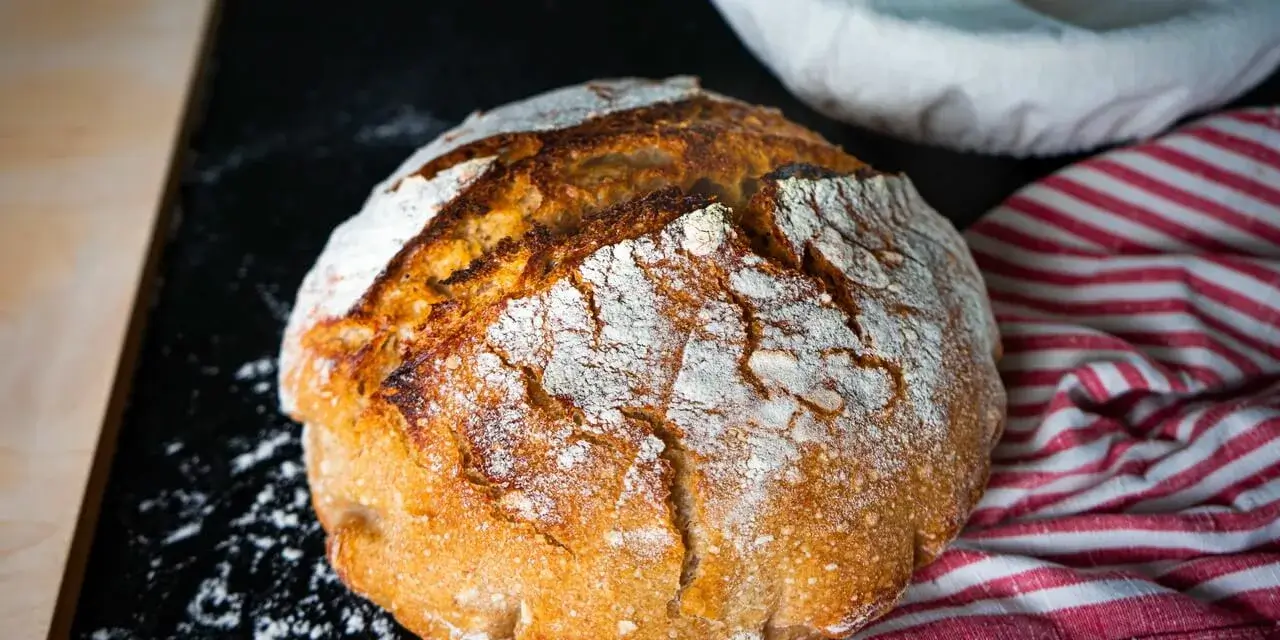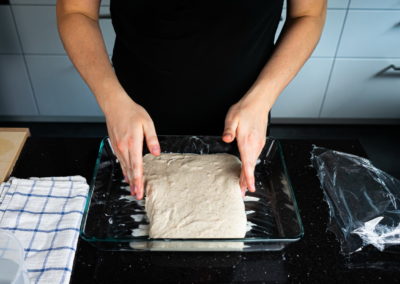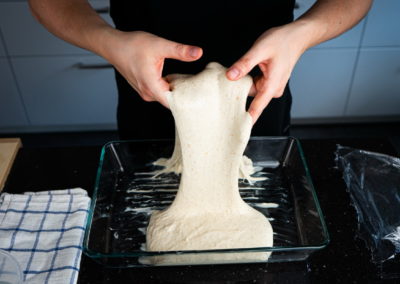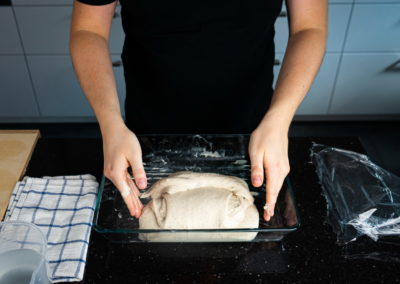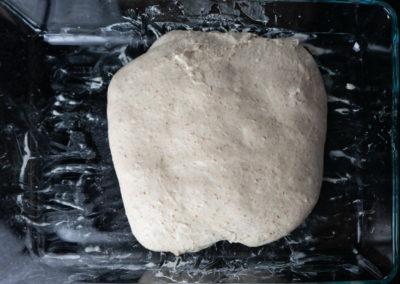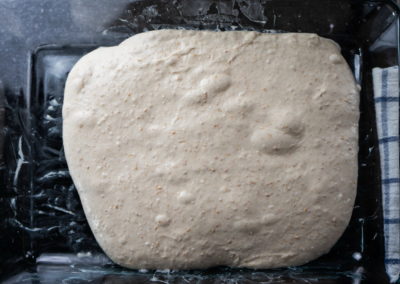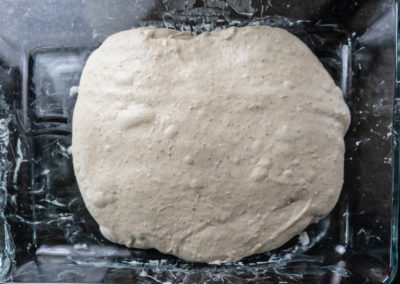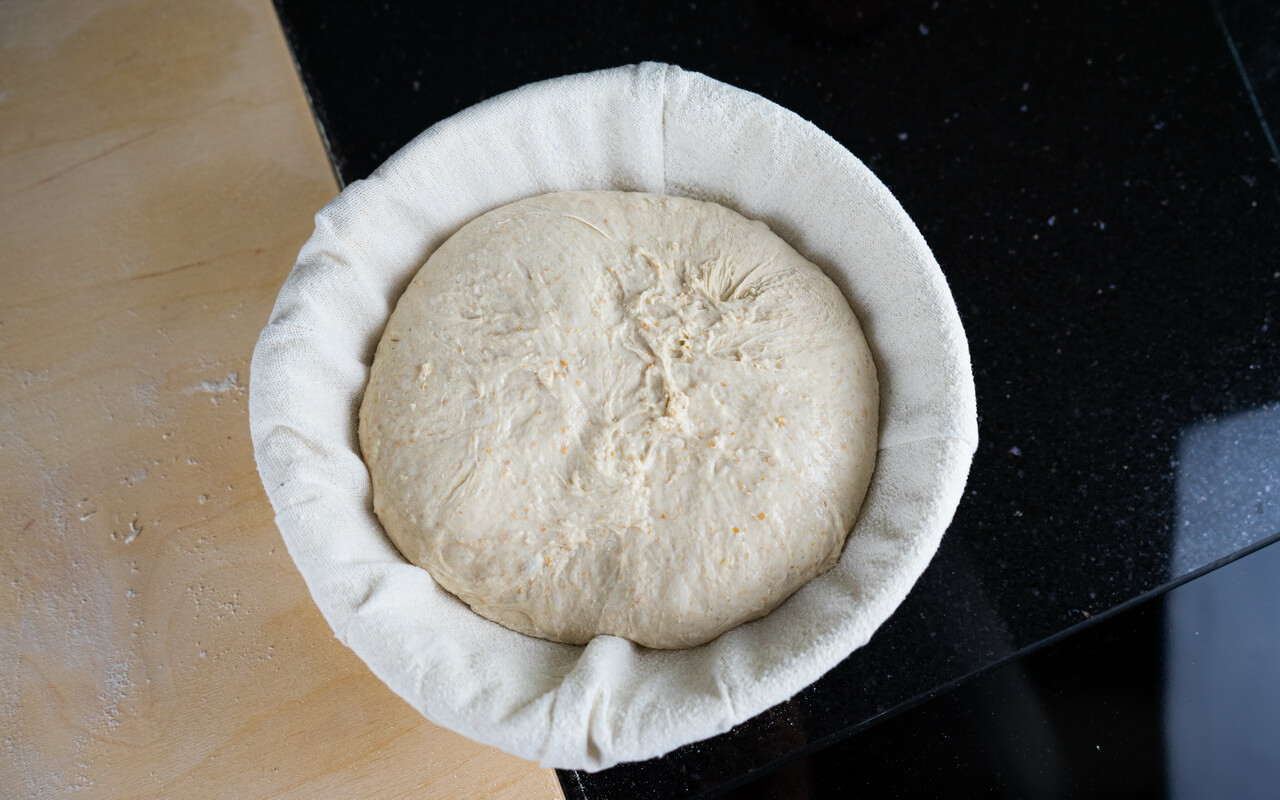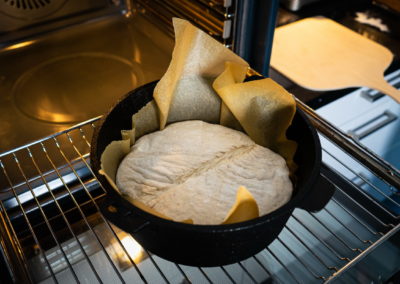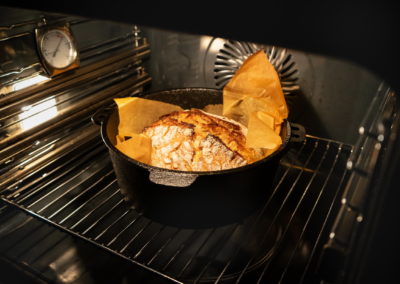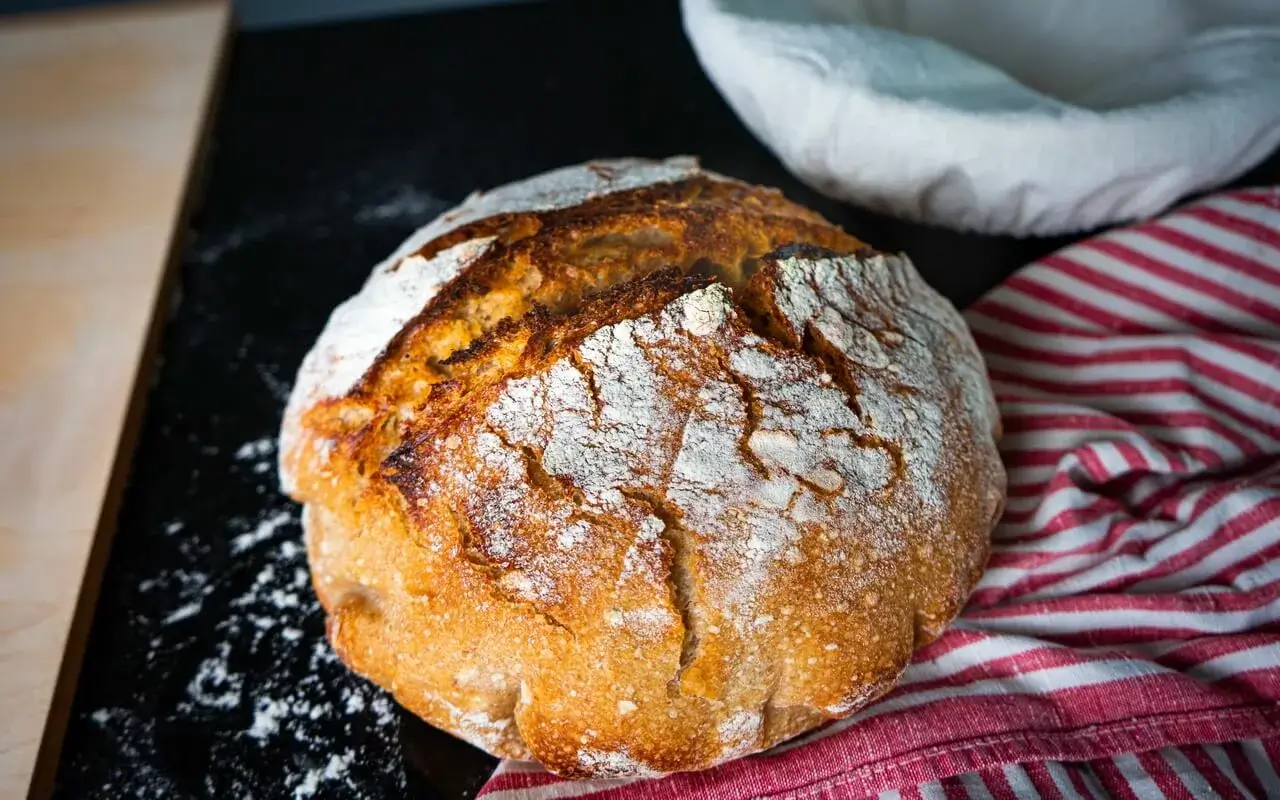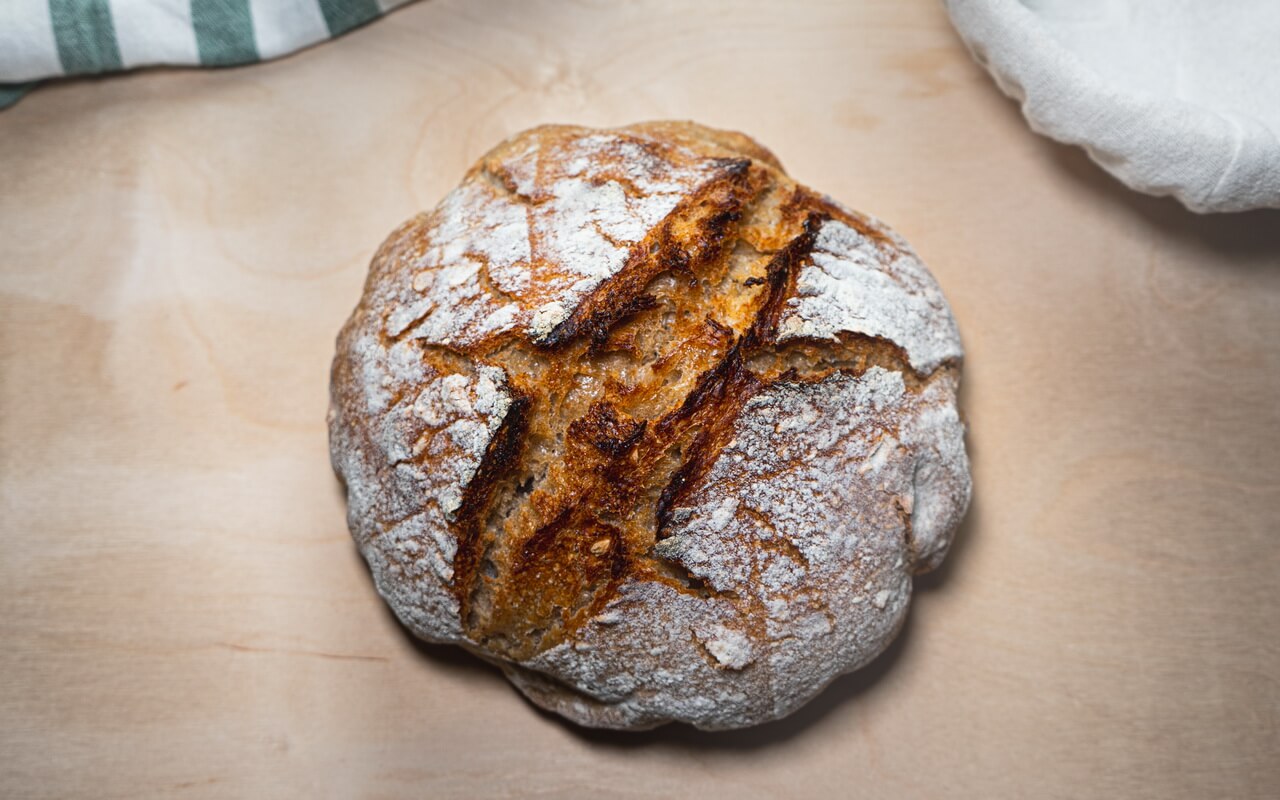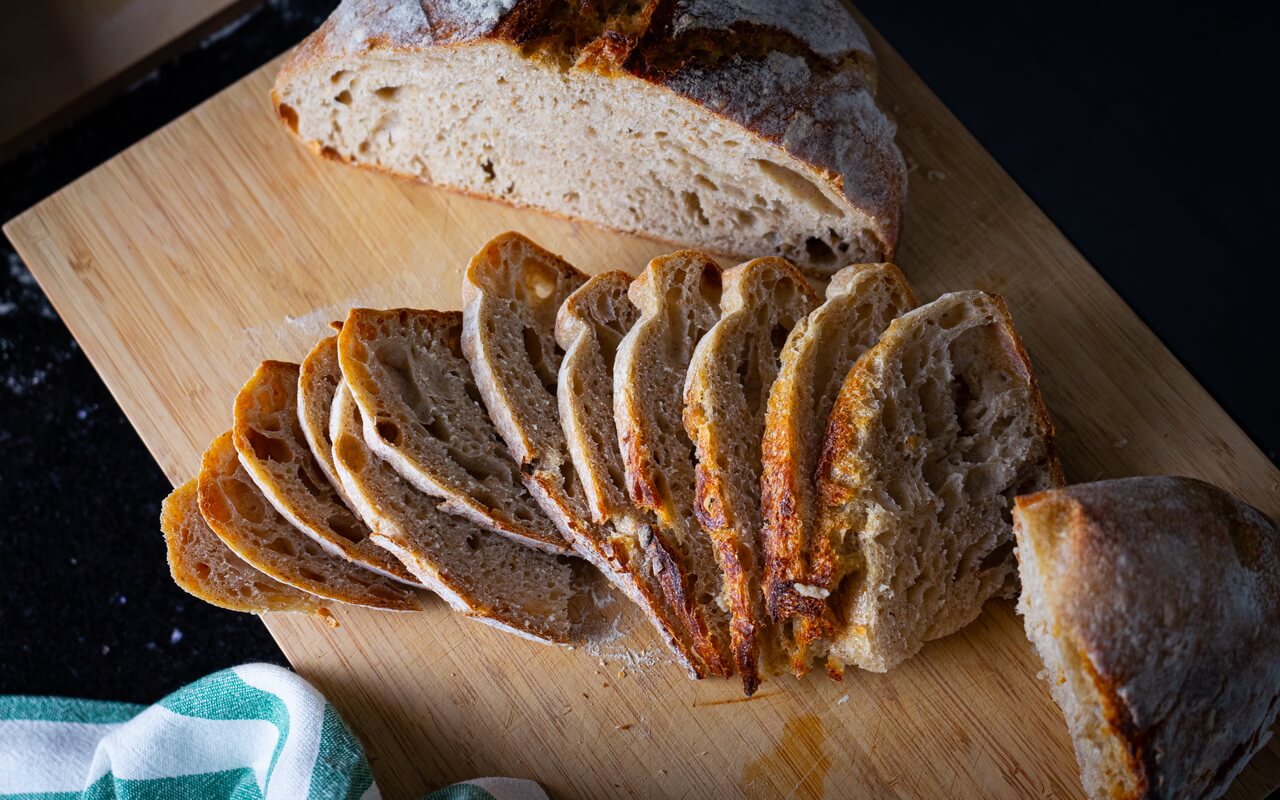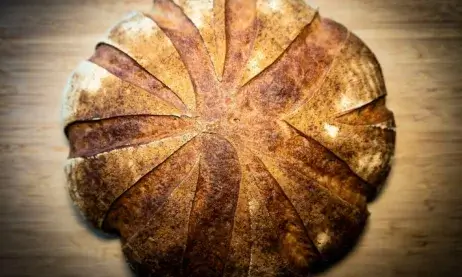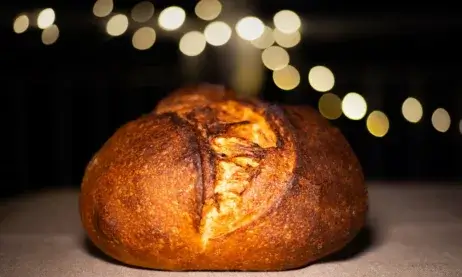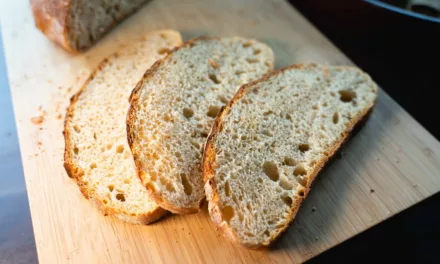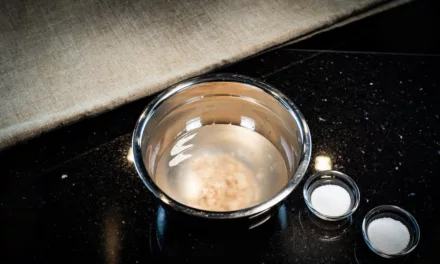Today we are sharing a recipe for a sourdough bread that was baked without any yeast and in a dutch oven. Even though we already baked quite some breads, this is the first one that rose this high without any yeast being used. This shows you how powerful a sourdough starter can get.
Take a look at the pictures to see how fluid the dough was while doing coil folds. It is even more fascinating when you see what this fluid dough became when baking it. If you are working with sourdough starters, this is a great recipe to see what your sourdough starter is capable of!
Things to know before you start
Time Schedule
| Steps | Work time | Waiting time |
| Levain | ~5 minutes | 12 hours |
| Autolyse | ~5 minutes | 1 hour |
| Mix | ~20 minutes | – |
| Bulk Fermentation, Coil fold | ~20 minutes | 5 hours |
| Shape | ~5 minutes | – |
| Proof | – | 2 hours |
| Bake | ~5 minutes | 45 minutes |
| Cool | – | 2 hours |
This beautiful sourdough bread will be ready to be eaten in about 24 hours, but it is recommended to wait a bit longer after baking it. That is because sourdough breads develop their full flavour after waiting another 24 hours.
Total ingredients
| Weight | Ingredient |
| 60 g | Sourdough starter – Preferably from rye flour |
| 510 g | All-purpose flour |
| 60 g | Whole wheat flour |
| 12 g | Salt |
| 430 g | Water |
You will have a dough of about 1072 g in total.
As mentioned in the introduction we won’t use any yeast. A healthy starter, flour, water and salt is all you need to bake a great sourdough loaf.
Difficulty
The difficulty for this sourdough bread is in the moderate category. This is mainly because of the higher hydration of about 76% which makes the dough pretty fluid and harder to handle.
Consider having a look at our recipe sourdough bread for beginners if you have never baked a sourdough bread before to get some insight.
Baking tools
You will need a dutch oven, round banneton proofing basket that you can find in our should have baking tools and a non-reactive container of at least 25 x 25 x 7 cm (one made out of glass would be perfect).
Steps
1. Levain
| Weight | Ingredient |
| 60 g | Sourdough starter – Preferably from rye flour |
| 60 g | Whole wheat flour |
| 60 g | Water – 50°C (122°F) |
- Mix your starter with the ingredients above
- Store sealed for 2 hours at 28°C (80,6°F)
- Afterwards store for another 12 hours at 5°C (41°F) in the fridge
2. Autolyse
| Weight | Ingredient |
| 450 g | All-purpose flour |
| 280 g | Water – 60°C (140°F) |
- Mix the 2 ingredients together
- Store sealed for 1 hour at 20-22°C (68-71,6°F)
3. Mix
| Weight | Ingredient |
| – | Levain |
| – | Autolyse |
| 60 g | All-purpose flour |
| 12 g | Salt |
| 90 g | Water – 25°C (77°F) |
- Mix all of the mentioned ingredients together with a stand mixer for 6 minutes on speed level one and 8 minutes on speed level two
- The dough will still be relatively fluid and stick to the bowl at the end of the mixing
4. Bulk Fermentation, Coil Fold
- Transfer your dough into a non-reactive container of at least 25 x 25 x 7 cm that you can seal (one made out of glass would be perfect)
- If your container has no lid, just use clingfilm like we did
- Cover the dough and let it rest for a total of 5 hours at 20-22°C (68-71,6°F)
- During that time stretch & fold the dough every 30 minutes (6 times in total) and after the 6th time let it ferment further for 2 more hours until 5 hours in total are reached
- As this is a pretty fluid dough we are going to use the coil fold technique:
- Remove the lid from your container
- Wet both of your hands in water
- Grab beneath the dough with both hands not directly in the middle but a bit more towards you
- Pull it up into the air until the bottom part of the dough doesn’t stick to the container anymore (be carefull so it doesn’t tear apart) and let the bottom part fold underneath the middle part
- Do the same with the top half of the dough
- Turn the container 90°C
- Repeat step 4 and 5
- If there are any bigger bubbles on top of the dough, just pinch them with your fingers
- Seal the container again
- The dough will strengthen more and more after each coil fold
- For example the first picture was taken after the first coil fold phase and the second one after the second coil fold phase
- The third picture was taken before the second coil fold and the fourth one before the third coil fold
5. Shape
- Flip your container upside down and get the dough carefully out on a floured surface
- Afterwards get it in shape by rounding
- As the dough has a high hydration the rounding could be tricky so just try your best
7. SCORE
- Cut out a piece of parchment paper big enough that it covers the bottom and sides of your dutch oven
- Place the parchment paper on the counter
- Gently take your dough out of the proofing basket by flipping it upside down on the parchment paper
- Make one long flat cut lengthwise (about 2 to 3 cm deep) on top of the loaf with a bread lame
8. Bake
- Place your dutch oven with the lid on top in the oven and preheat it to 250°C (482°F) for ~45 minutes with the upper and lower heat function
- Remove the lid of the dutch oven (use oven mitts so you don’t burn your hands!), place the dough inside and seal it again with the lid for 45 minutes
- After 20 minutes lower the temperature to 230°C (446°F) and remove the lid from the dutch oven so you get a nice crust on top
9. Cool
- Let your sourdough loaf cool for 2 hours on some kind of grid
- As mentioned in the beginning, you should wait a total of about 24 hours before you cut into the loaf for the very best taste
Conclusion
Crust
This full sourdough bread has a lovely brown and crunchy crust. It is mild and the perfect cover for the soft and slightly sour crust.
Crumb
The crumb is soft and juicy with big and uneven pores.
Taste
As this bread is completely based on sourdough it has a mild but slightly sour taste. We disovered that the more you chew it, the more sour it gets. However, this doesn’t harm the taste at all and is a great alternative to all the other breads we baked so far.
Goes good with
As explained above, the taste of this sourdough bread is slightly sour but still mild. Therefore, we feel this is a bread that should be combined with more hearty things such as ham, cheese or eggs. We wouldn’t recommend to eating it with marmalde or honeys but of course this is entirely up to you.

